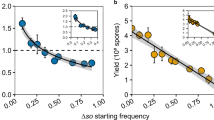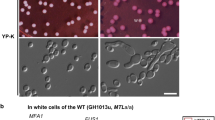Abstract
BURGEFF1 was the first to produce evidence of the formation of a sexual factor by mated strains of the fungi Phycomyces blakesleeanus, Mucor mucedo and possibly all other members of the Mucorales. This substance, which is produced in very small amounts, is held responsible for the induction of the formation of gametangia. It appears that it is not species specific, for M. mucedo exhibits a positive reaction with preparations obtained, for example, from Blakeslea trispora as well as from P. blakesleeanus. Plempel2 supposed that the sexual factor is a mixture of two substances that are produced by the plus and the minus strain of the fungus respectively.
This is a preview of subscription content, access via your institution
Access options
Subscribe to this journal
Receive 51 print issues and online access
$199.00 per year
only $3.90 per issue
Buy this article
- Purchase on Springer Link
- Instant access to full article PDF
Prices may be subject to local taxes which are calculated during checkout
Similar content being viewed by others
References
Burgeff, H., Bot. Abh., 4 (1924).
Plempel, M., Planta, 59, 492 (1963).
Zechmeister, L., Progress in the Chemistry of Organic Natural Products, XVIII, 223 (1962).
Caglioti, L., Cainelli, G., Camerino, B., Mondelli, R., Prieto, A., Quilico, A., Salvatori, T., and Selva, A., La Chimica e l'Industria, 46, 961 (1964).
Author information
Authors and Affiliations
Rights and permissions
About this article
Cite this article
VAN DEN ENDE, H. Sexual Factor of the Mucorales. Nature 215, 211–212 (1967). https://doi.org/10.1038/215211a0
Received:
Issue Date:
DOI: https://doi.org/10.1038/215211a0
This article is cited by
-
Bacterial endosymbionts influence host sexuality and reveal reproductive genes of early divergent fungi
Nature Communications (2017)
-
Metabolism of vitamin A, structure and synthesis of metabolites, and their biological activity (Review)
Pharmaceutical Chemistry Journal (1984)
-
Carotenogenesis: Possible mechanism of action of trisporic acid in Blakeslea trispora
Experientia (1977)
-
Trisporic acid synthesis in mated cultures of the fungus Blakeslea trispora
Archiv f�r Mikrobiologie (1972)
-
Physiology of sex inMucorales
The Botanical Review (1971)
Comments
By submitting a comment you agree to abide by our Terms and Community Guidelines. If you find something abusive or that does not comply with our terms or guidelines please flag it as inappropriate.



